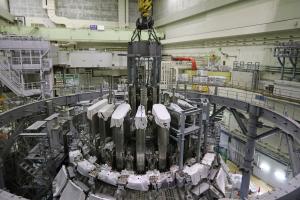"ITER satellite" to begin operating next year
In a major assembly milestone for the JT-60SA tokamak, the 12-metre-tall central solenoid was successfully installed by overhead crane on 8 May. Japanese television was there to film the operation.
JT-60SA will begin operating in 2020 as a fully superconducting tokamak capable of confining high-temperature deuterium plasmas. The experiment—a major modification of the former JT-60U tokamak at the Naka Fusion Institute in Japan—is designed to address key physics for ITER and next-stage devices.
The single heaviest component—the central solenoid—was lowered into the centre of the donut-shaped machine on 8 May (see videos below).
Experts highlight the complementarity of the JT-60SA and ITER machines, which record overlaps in areas including magnet conductor design and testing, cryoplant design, in-vessel remote handling, and heating and current drive systems. By coming on line before ITER, JT-60SA will allow the exploration of ITER-relevant high density plasma regimes and the optimization of configurations for ITER and the next-phase device DEMO. (See more about the scientific objectives of JT-60SA here.)


